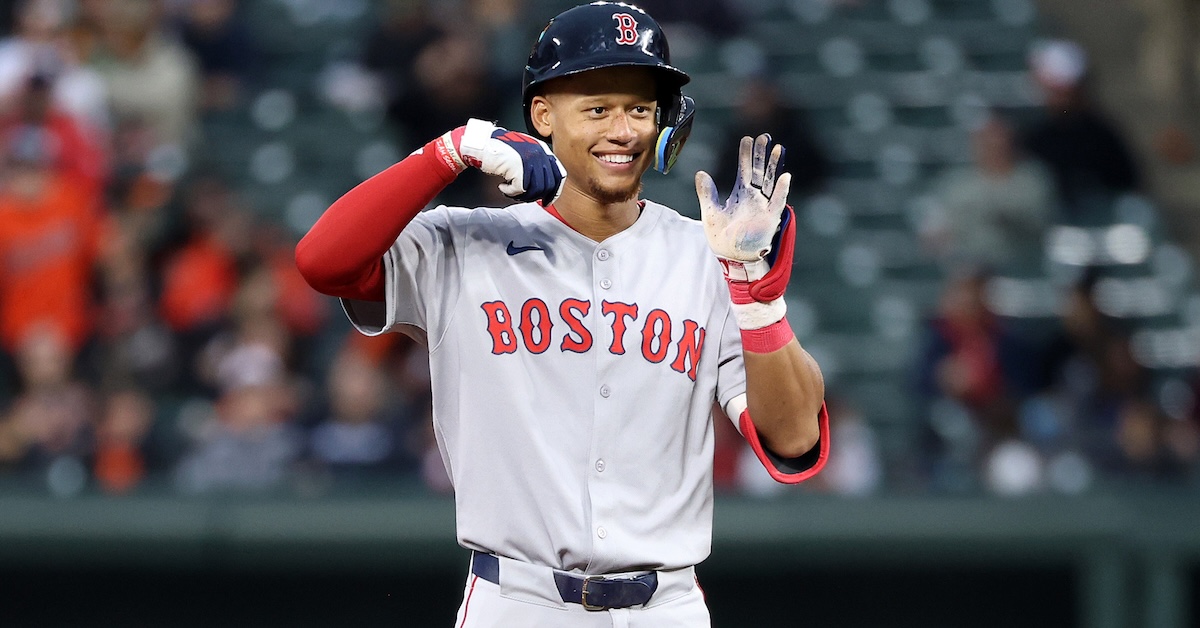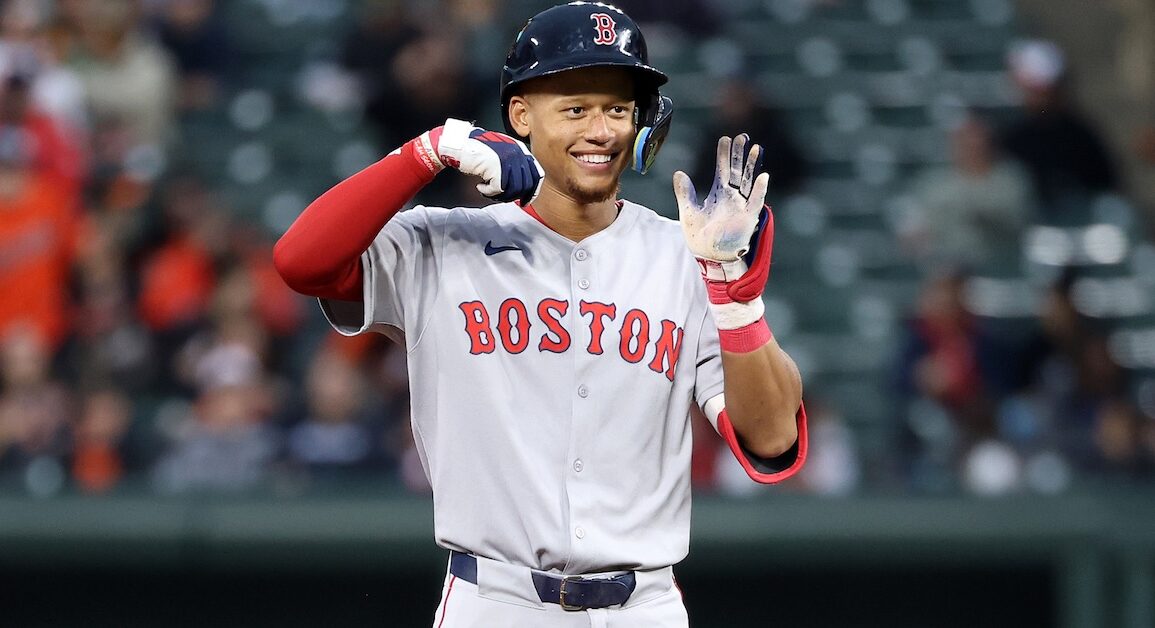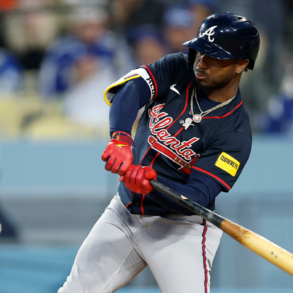Red Sox Sign .400 Hitter to Long-Term Extension

Kristian Campbell has come a long way in a short time. Less than two years after being drafted by the Red Sox out of Georgia Tech, with just 137 minor league games under his belt, he placed seventh on our Top 100 Prospects list in February, and won the starting second base job during spring training. Now, with just a week of major league service time under his belt, Campbell has agreed to an eight-year, $60 million extension that includes a pair of team options and escalator clauses that can push the contract’s value past the $100 million mark. It’s a deal that provides both security for Campbell and some opportunity for growth, though it’s not hard to notice the much more lucrative extension that the Padres announced for Jackson Merrill on Wednesday as well and wonder whether Campbell should have waited. Either way, the Red Sox have ensured that another talented youngster will be part of their foundation in the coming years.
The 22-year-old Campbell is raking at a .400/.500/.750 (258 wRC+) clip through the first week of his major league career. So far, five of his eight hits have been for extra bases, including a 431-foot homer off the Rangers’ Jacob Webb on Saturday. He celebrated the news of his extension on Wednesday night with a pair of opposite-field doubles off Orioles starter Zach Eflin.
While Campbell was a co-favorite to win AL Rookie of the Year honors in our annual staff poll, nobody expects him to continue at this breakneck pace. Still, buzz about an extension had been circulating in recent days, and while this move isn’t nearly as big as the six-year, $170 million extension the Red Sox announced on Monday for lefty Garrett Crochet, the team clearly views Campbell as an important piece of its future.
The Red Sox drafted Campbell with a fourth-round competitive balance pick in 2023. He was an age-eligible redshirt freshman with one year of college experience at the time, an outstanding slash-and-dash leadoff man (to use Eric Longenhagen’s term) who was one of the most difficult players to strike out in all of Division I (7.8%). Since signing for a $492,700 bonus, he hasn’t stayed in one place for long; after playing eight games for the Red Sox’s Florida Complex League squad, he finished the 2023 season with 14 games at High-A Greenville, returned there for 40 games to start ’24, followed by 56 games at Double-A Portland and 19 at Triple-A Worcester. At those three stops last year, he slashed .330/.439/.558 with 20 homers and 24 steals, earning Baseball America Minor League Player of the Year honors and a host of other accolades. His 180 wRC+ was the highest of all players with at least 250 plate appearances in the affiliated minors last season.
As you might surmise from those impressive numbers, Campbell has added enough bash to his slash-and-dash to change his profile. Specifically, his prospect grade has risen from 45+ FV to 60 FV since last July. From Longenhagen’s more recent writeup:
The Red Sox have essentially made him into a Jarren Duran sequel, taking another speedy, contact-oriented second baseman and making subtle changes to his swing and approach, resulting in a seismic shift to his offensive output, which now includes big power.
Campbell is now swinging with damage-seeking intent and has been able to lift the ball more (three degrees of launch in 2023, nine degrees in 2024). The power he’s generating with his new style is shocking. His high-end exit velocities are now comfortably plus on the big league scale (he hit a ball 114 mph last year), and he’s doing huge damage to all fields.
Longenhagen’s only real area of concern regarding the 6-foot-3, 191-pound Campbell is his defense, which he graded as 30/40 (present/future) with his arm a 40, and noted that his position could be a question. A couple other outlets that also ranked Campbell among this year’s top 10 prospects placed 50 grades on both his defense and his arm, and another one saw him as a potential plus defender at the keystone, so it’s worth noting that there’s a range of opinion on the subject.
Longenhagen noted that while Campbell has the speed for center field, he’s very raw there, with questionable reads, especially on balls in front of him. In Duran and Ceddanne Rafaela, the team already has two players more than capable of manning the middle pasture and is likely to push no. 2 prospect Roman Anthony — who has begun this season at Triple-A Worcester and could reach Boston this summer — to a corner.
As I noted a couple of weeks ago, the organization’s high regard for Campbell helps to explain this spring’s drama concerning the alignment of the infield. Boston signed free agent Alex Bregman — the reigning AL Gold Glove winner at third base — to a three-year, $120 million deal in mid-February despite the presence of incumbent Rafael Devers, who’s entering the second season of his 10-year, $313.5 million extension. During the pursuit of Bregman, manager Alex Cora had spoken of envisioning him as a second baseman when he served as an Astros coach, and the widely held assumption within the industry was that the newcomer would switch to the keystone.
That Devers was shut down last September due to problems with both shoulders was one factor in Boston’s keeping Bregman at the hot corner despite the incumbent’s public protestations, but the team’s glut of young talent at second base was another. Campbell had to beat out Vaughn Grissom, David Hamilton, and Marcelo Mayer (no. 57 on our Top 100) to earn the second base job, which he did despite starting slowly in spring training, with an 0-for-11 featuring eight strikeouts and some shakiness afield. That the Red Sox showed such patience with Campbell despite such depth, and even with the blowback from Devers, was a strong sign of their faith in his readiness.
That said, Campbell isn’t strictly a second baseman, at least not yet. On Saturday, Hamilton started at second, bumping Campbell to left field, with Duran shifting from left to center, sending Rafaela — generally the starter there but the weakest hitter of the bunch — to the bench; he made a late-inning appearance in center after Duran moved to right within a sequence of late-inning moves.
Turning to the extension, Campbell gets a $2 million signing bonus as well as a $1 million salary for this year (a bump from the $760,000 minimum he was scheduled to make). He’ll then earn $2 million next year, $3 million in 2027, and $4 million in ’28, which would have been his first year of arbitration eligibility. From there his salary bumps to $6 million in 2029 and $9 million in ’30, which would have been his final year before becoming eligible for free agency, and to $13 million and $16 million for what would have been his first two years of free agent eligibility, with club options of $19 million (with a $4 million buyout) for 2033 and $21 million (no buyout) for ’34. If both options are exercised, that comes out to $96 million for 10 years.
Those are just base salaries. Campbell also has escalator clauses that can raise his next year’s salary by as much as $2 million: $200,000 for All-Star selection, $250,000 for finishing anywhere from sixth through 10th in the MVP voting, $500,000 for fourth or fifth, $1 million for second or third, and $2 million for winning the award.
As Baseball America’s J.J. Cooper noted, the Red Sox remain eligible to qualify for the Prospect Promotion Incentive (PPI) pick because they waited until after Campbell’s debut to extend him. If he were to win Rookie of the Year honors, he’d earn them a pick at the end of the first round of next year’s draft, and likewise if he were to finish among the top three in MVP voting anytime from 2025–27. Had the Sox extended him before his debut, as the Brewers did with Jackson Chourio last year, they wouldn’t have been able to qualify.
While Crochet’s extension is bigger than the free agent contracts of all but a handful of the highest-paid starting pitchers, Campbell’s is much lower given his age and experience level. Still, it’s a larger deal than either of the other two extensions the team has completed since Craig Breslow took over as chief baseball officer in October 2023, surpassing those of both Rafaela (eight years, $50 million, with one club option) and righty Brayan Bello (six years, $55 million, also with one club option). The latter does have a higher average annual value ($9.17 million vs. $7.5 million).
As for what to expect from Campbell, I asked Dan Szymborski to whip up a ZiPS projection. He ran one earlier this year, when Campbell placed 10th on the ZiPS Top 100 back in February. At the time, Szymborski wrote that Campbell projects as a good starter and adding, “ZiPS doesn’t think his ceiling is as high as some of the guys who rank ahead of him on the Top 100, but he’s a pretty low-risk prospect.”
With the caveat that this is a long projection based on a very short professional track record (albeit one augmented by Statcast minor league batted ball data and spring training data), here’s Campbell’s updated ZiPS projection at the time of the extension:
| Year | Age | AVG | OBP | SLG | PA | H | HR | RBI | BB | SO | SB | OPS+ | WAR | Proj Sal ($M) |
|---|---|---|---|---|---|---|---|---|---|---|---|---|---|---|
| 2025 | 23 | .261 | .346 | .420 | 502 | 118 | 13 | 71 | 50 | 120 | 13 | 110 | 2.3 | 0.8 |
| 2026 | 24 | .261 | .349 | .424 | 526 | 123 | 14 | 75 | 54 | 120 | 13 | 112 | 2.6 | 0.8 |
| 2027 | 25 | .258 | .347 | .423 | 546 | 126 | 15 | 79 | 57 | 119 | 13 | 111 | 2.7 | 0.8 |
| 2028 | 26 | .256 | .346 | .425 | 562 | 129 | 16 | 82 | 59 | 118 | 12 | 112 | 2.8 | 4.4 |
| 2029 | 27 | .254 | .345 | .425 | 572 | 130 | 17 | 83 | 61 | 118 | 12 | 111 | 2.8 | 8.0 |
| 2030 | 28 | .254 | .346 | .424 | 573 | 130 | 17 | 83 | 61 | 117 | 11 | 111 | 2.8 | 12.3 |
| 2031 | 29 | .254 | .345 | .423 | 569 | 129 | 17 | 82 | 61 | 116 | 10 | 111 | 2.7 | 28.0 |
| 2032 | 30 | .253 | .344 | .420 | 557 | 126 | 16 | 80 | 59 | 115 | 9 | 110 | 2.5 | 26.1 |
| 2033 | 31 | .255 | .346 | .422 | 557 | 127 | 16 | 80 | 59 | 115 | 9 | 111 | 2.5 | 26.9 |
| 2034 | 32 | .254 | .345 | .418 | 538 | 122 | 15 | 76 | 57 | 112 | 8 | 109 | 2.2 | 24.6 |
Not shown there is ZiPS’ skepticism of Campbell’s defense, which lines up with Longenhagen’s scouting assessment; he’s about two to four runs below average at second base annually for the above stretch, which puts a drag on his WAR. Still, as his ZiPS Top 100 ranking underscores, he is a pretty valuable player, and with a bit of growth, he can be an All-Star to match that 60-FV grade.
The ZiPS valuation for the eight guaranteed years of Campbell’s deal comes in at $81 million, suggesting he may have sold himself a bit short, but given the error bars on that projection, I don’t think this counts as egregious. If he were three years younger and had a higher ceiling, he might have come closer to Chourio’s eight-year, $82 million deal, but that’s not the case.
I don’t think there’s much point in bemoaning Campbell for falling short of Chourio’s deal or the ZiPS contract projection, but I do think one can look to Merrill’s extension for an example of what might have been. Merrill already has banked a 5.3-WAR season at age 21; I would have picked him as my NL Rookie of the Year, ahead of Paul Skenes given the success of his spring position change and his thriving in the pressure of playoff race, and I’m hardly alone. Having established himself as a star in the making, Merrill received a deal that guarantees him $135 million for nine years (starting in 2026, his age-23 season), with incentives and options that could push the value to $204 million. Holy cow!
We don’t know whether the Red Sox would have offered Campbell a larger extension down the road if he’d chosen to wait, but the Crochet extension and past ones for Devers and Xander Bogaerts (completed under the regimes of Chaim Bloom and Dave Dombrowski, respectively) illustrate that the organization is not averse to doing so for star-caliber players with more experience. Still, it’s tough to fault a 22-year-old for ensuring himself generational wealth when he’s still getting his sea legs in the bigs. If he’s as good as the Red Sox think he will be, he’s got bigger things ahead of him.
Brooklyn-based Jay Jaffe is a senior writer for FanGraphs, the author of The Cooperstown Casebook (Thomas Dunne Books, 2017) and the creator of the JAWS (Jaffe WAR Score) metric for Hall of Fame analysis. He founded the Futility Infielder website (2001), was a columnist for Baseball Prospectus (2005-2012) and a contributing writer for Sports Illustrated (2012-2018). He has been a recurring guest on MLB Network and a member of the BBWAA since 2011, and a Hall of Fame voter since 2021. Follow him on BlueSky @jayjaffe.bsky.social.
This post was originally published on this site be sure to check out more of their content.








